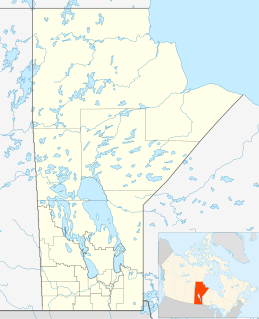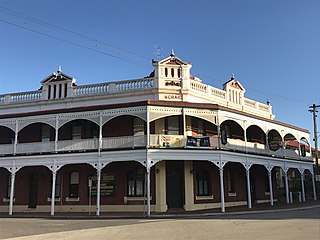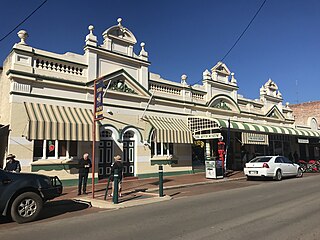
The Herbert Hoover National Historic Site is a unit of the National Park System in West Branch, Iowa, United States. The buildings and grounds are managed by the National Park Service to commemorate the life of Herbert Hoover, the 31st President of the United States. The park was established in 1965, shortly after it was named a National Historic Landmark. It now encompasses 186.8 acres (75.6 ha).
This aims to be a complete list of the articles on real estate.
Stamp duty is a tax that is levied on single property purchases or documents A physical stamp had to be attached to or impressed upon the document to denote that stamp duty had been paid before the document was legally effective. More modern versions of the tax no longer require an actual stamp.
Closing is the final step in executing a real estate transaction.

Newington is a suburb of Sydney, in the state of New South Wales, Australia. It is 16 kilometres west of the Sydney central business district, in the local government area of City of Parramatta.

York is the oldest inland town in Western Australia, situated on the Avon River, 97 kilometres (60 mi) east of Perth in the Wheatbelt, on Ballardong Nyoongar land, and is the seat of the Shire of York.

Kleefeld is a small community in the Rural Municipality of Hanover in the Canadian province of Manitoba. It was settled in the 1874 and was originally called Gruenfeld.
Marryatville is a small suburb about 4–5 kilometres (2.5–3.1 mi) east of Adelaide's central business district, in the local council area of City of Norwood Payneham St Peters. Comprising low- to medium-density housing, two large schools, a church and several shops, it also has two creeks running through it. The first European settler on the land was George Brunskill in 1839, with part of the land purchased and laid out as a village in 1848 by James Philcox.

Until recently, the limestone building at 445 Smith Avenue North, St. Paul, Minnesota, United States, was known in surveys and local architectural history books as the Anthony Waldman House. However, recent research and analysis of the building has revealed that the Waldman House was not in fact built by Waldman, and was not originally a "house" either. Instead, the structure was a small commercial building with residential quarters on the second floor. Evidence of this commercial design include a side porch/loading dock facing the alley to the north ; obvious stone in-filling of the first-floor shop-front windows; a large structural beam above the one-time shop front that supported the second-story stonework; photographic evidence from the 1940s of remnants of the original first-floor commercial cornice ; physical evidence of a central entrance step into the shop; and wooden sleepers that served as nailers for decorative wooden pilasters or perhaps signs at either side of the shop windows below the cornice. Documentary evidence suggests that the stone portion of the building dates to the late fall of 1857, coinciding with the onset of the Panic of 1857. Another unexpected discovery is that parts of the wood frame addition to the rear of the stone building actually predate the stone portion, making the latter the true "addition." The research is ongoing, and no doubt the Waldman House has more stories to tell.

The Cherryfield Historic District encompasses the historic village center of Cherryfield, Maine. This area is distinctive for its collection of high-quality 19th century architecture, which is unique in rural contexts in the state. The district was listed on the National Register of Historic Places in 1990.
The Drum Creek Treaty came about from the controversy over the Sturges Treaty of 1868. The Sturges Osage Treaty was a treaty negotiated between the United States and the Osage Nation in 1868. The treaty was submitted to both the United States House of Representatives and the United States Senate but was never ratified.

The Double-O Ranch Historic District is located west of Harney Lake in Harney County in southeastern Oregon, United States. At one time, the Double-O Ranch covered over 17,000 acres (69 km2). The ranch was owned by Bill Hanley, a well-known cattle baron and Bull Moose progressive. In 1941, the United States Government purchased most of the Double O Ranch property and added it to the Malheur National Wildlife Refuge. The two remaining Double-O Ranch buildings are now listed on the National Register of Historic Places.

Pearsons Corner is an unincorporated community in Kent County, Delaware, United States. Pearsons Corner is located at the intersection of Delaware Route 8 and Delaware Route 44 west of Dover.

Plumb's Chambers is a heritage-listed pair of shops at 82 & 84 Fitzroy Street, Warwick, Southern Downs Region, Queensland, Australia. Despite being believed to be Queensland's oldest shop, No. 82 was demolished on 27 October 2014. However, a restoration of No. 84 commenced in March 2015. They were built from 1860s to c. 1910. It is also known as Medical Hall. It was added to the Queensland Heritage Register on 3 November 1997.

Avon Terrace it is the main street of the town of York, Western Australia, and is lined with heritage-listed buildings.

Dinsdale's Shoe Emporium is a heritage-listed building on Avon Terrace in York, Western Australia, constructed by a former mayor.

The Castle Hotel in York is reputedly the oldest inland hotel in Western Australia. It was constructed and owned by the Craig family for 137 years.
John Henry Monger Snr arrived in Western Australia as an assisted migrant in 1829. After a short period running a mill at what became Lake Monger, he established a hotel and store in York and went on to become one of the richest men in the colony.

The York Palace Hotel, in York, Western Australia, was a major building constructed in 1909 during a building boom in that town in the first decade of the 20th century.

The York Motor Museum is a motor vehicle museum on Avon Terrace in York, Western Australia. It is housed in a group of shops and commercial premises "unified by a classical parapet with classical cappings and balusters" constructed by the Windsor family in 1908.














